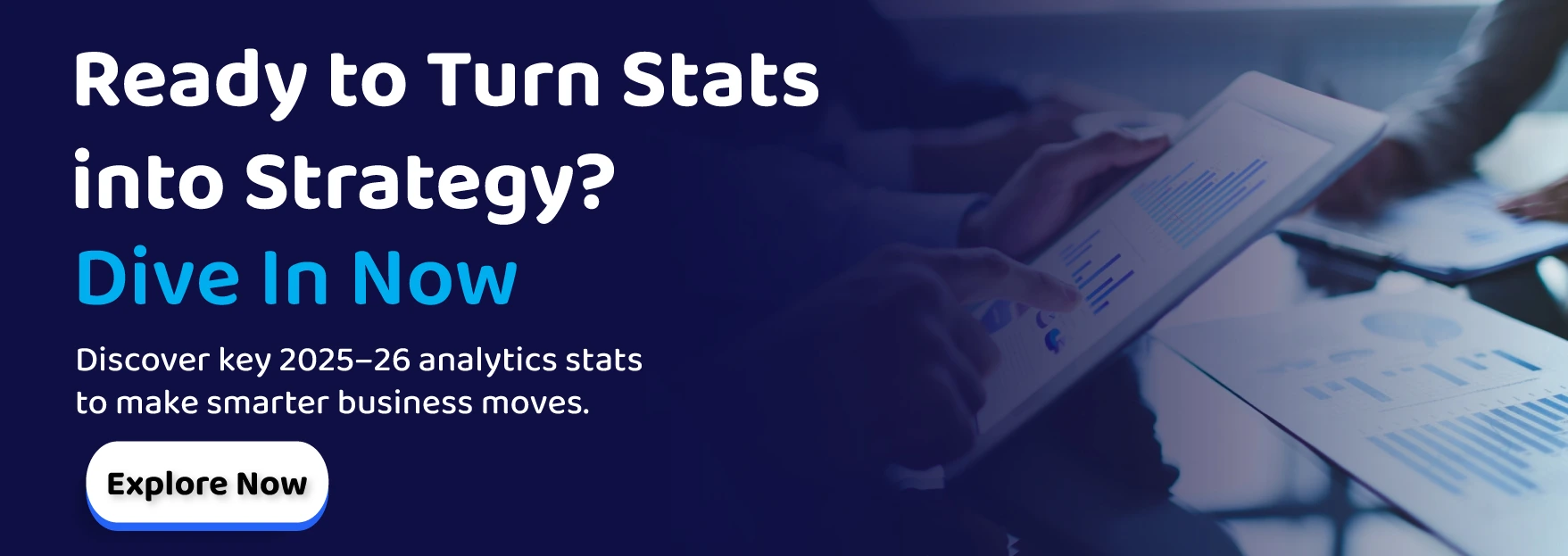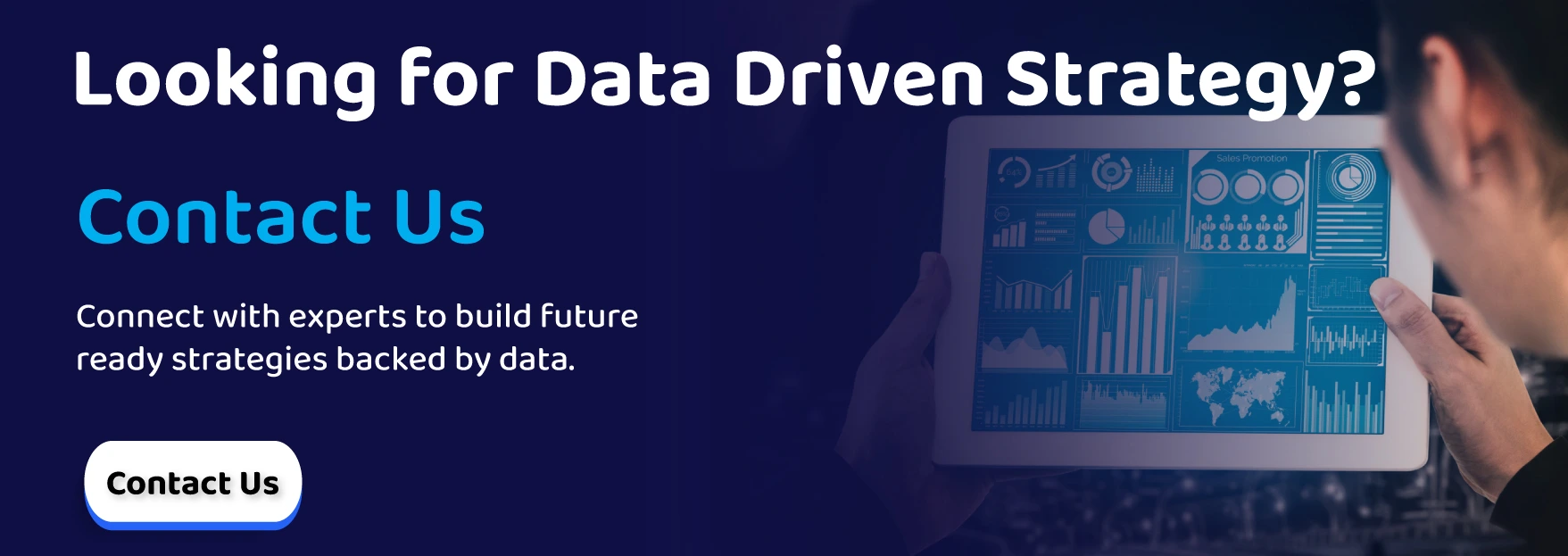In the current environment, data drives innovation & decision-making, and firms must leverage data analytics to maintain a competitive edge & growth. Data analytics includes systematic interpretation of data to measure insights, identify patterns & build strategic decisions.
Data analytics has evolved rapidly from a manual to a labor-intensive process, allowing effective data handling. The emergence of these advanced data analytics solutions offers massive datasets handling & extracting actionable data insights. The years 2025-2026 are predicted to be crucial for analytics strategies due to the accelerating adoption of data-driven decisions. Read the following blog to learn the necessity of data analytics in building decisions.
➥ The Business Case for Data Analytics
❑ Economic Impact of Analytics
Advanced analytics services bring a significant economic impact on organizations by driving revenue growth, accelerating operational effectiveness, and limiting costs. Additionally, data analytics allow better decision-making and accelerate customer experience to fuel innovation based on trend identifications & patterns. Organizations effectively utilize data analytics to achieve a competitive edge by personalizing customer interaction, streamlining the process & mitigating risks.
❑ Executive-Level Perspective
Based on Salesforce data analytics statistics, around 80% of firms consider data as a crucial form of resource to the decision-making process. 73% of organizations claimed that the data reduces the uncertainty & accelerates decision-making accuracy. The business case for data analytics at the executive level centers on demonstrating how data-driven insights enhance effectiveness, profitability, and competitive benefits.
It necessitates outlining achievable, measurable goals, delivering the roadmap for implementation & ongoing management. C-suite executives are aiming to invest in digital transformation to accelerate the organization’s impact & adapt to changing market dynamics. It includes better spending on IT infrastructure and also focuses on designing necessary skills within the workforce to drive organizational value.
➥ Core Benefits of Data-Driven Decision-Making
❑ Enhanced Operational Efficiency
The recent advanced data analytics solutions survey suggests that 58% of firm leaders tend to follow instincts rather than data in decision-making. Data-driven decision-making significantly improves operational effectiveness by allowing firms to make faster & precise data, leading to improved resource allocation & processed workflows.
Advanced analytics services software such as SplashBI assists in identifying revenue-generating ideas, accelerates operational workflows & and optimizes productions. Reduction in redundant processes via analytics tools is possible through this tool.
❑ Competitive Advantage
Based on McKinsey & Company reports on big data analytics statistics, companies using analytics outperform competitors in Customer acquisition by 23 times higher chances of success. Additionally, the statistics for data analytics reports said that companies leveraging analytics outperform competitors by 20% in time-to-market. 54% of firms with advanced data analytics have seen improved revenue, whereas 44% of them have gained competitive benefits.
❑ Customer-centric Innovation
Data-driven decision-making and customer-centric innovation allow organizations to understand customer preferences. Advanced data analytics services give access to personalization metrics that lead to targeted & effective approaches for client satisfaction.
Also read :- Top 10 Data Analytics Companies in India Trusted by Business Leaders
➥ Key Statistics by Industry
❑ Finance & Banking
The finance & banking industry widely uses AI for seamless banking operations. Within 12 months of putting multi-modal biometric identification systems in place, banks saw an average 66% decrease in account takeover fraud, including a thorough investigation conducted by KPMG that looked at 150 financial institutions in 18 different countries.
❑ Healthcare
By employing trend analysis and historical data to spot possible dangers before they become more serious, diagnostic analytics improves risk management. AI-driven diagnostics can achieve far greater overall accuracy. For instance, one study revealed an accuracy rate of 93%, which was higher than the average of 78% for traditional approaches.
❑ Retail & eCommerce
For retail and e-commerce, data analytics is essential because it provides insights that improve consumer satisfaction, increase sales, and streamline operations. Predictive analytics is used to estimate demand and trends, and key areas include pricing optimization, inventory management, and consumer behavior analysis. Higher revenue, better customer retention, and higher operational efficiency are all possible outcomes of effective data utilization. At a CAGR of 21.2%, big data analytics in the retail industry is expected to reach $20.22 billion by 2030 from $7.73 billion in 2025.
❑ Manufacturing & Supply Chain
In manufacturing and supply chain management, data analytical services are essential for raising overall performance, cutting expenses, and increasing efficiency. Overall, supply chain expenses have been reduced by 5–10% for businesses that use data analytics.
➥ Technology Trends Driving the Shift
❑ Growth of Cloud-Based Analytics
The cloud-based analytics witnessed significant growth because of improved volume & data complexity, driving the requirement for cost-effective & scalable solutions. The market of advanced data analytics solutions is expected to grow by USD 147.19 billion by 2032. The growth is fueled by the traits of cloud analytics, including scalability, flexibility & improved data collaboration.
❑ Democratization of Data (Self-Service Analytics)
In order to bridge the technological gap caused by the lack of developers, 84% of companies are implementing low-code or no-code solutions based on statistics with data analytics. Data democratization refers to making data & its insights accessible to a wider range of people within an organization. It involves breaking down the barriers that prevent users from analyzing, accessing & utilizing data effectively.
❑ Integration of NLP and Conversational BI
The integration of NLP & conversational BI converts data analytics by making it more accessible. NLP allows users to interact with data through natural language, enabling them to ask questions & receive insight without making them complex. Additionally, it improves decision-making speed through accessible insights with growth in the usage of AI assistants for data queries.
➥ Data Privacy, Security & Governance
❑ Regulatory Landscape
Organizations must negotiate rules and regulations in several jurisdictions due to the changing and complicated regulatory environment around data analytics. Strict guidelines for data collection, processing, and storage are enforced by laws like the CCPA and GDPR, which place a strong emphasis on transparency, purpose limitation, and data minimization. According to Fortune Business Insights research, 68% of businesses allocate a sizable amount of their IT budget to data management, storage, and security.
❑ Ethical Analytics Practices
Fairness, openness, and individual privacy are given top priority in data analysis by ethical analytics techniques. This entails giving careful thought to the collection, usage, and sharing of data to make sure it complies with legal and ethical criteria.
➥ Challenges in Realizing Value from Analytics
❑ Data Silos and Fragmentation
According to statistics in data analytics, 4% of professionals said that their current customer data strategy’s biggest difficulty was siloed data. Data Silos & fragmentation cause significant complexity to realize the full value of analytics. The complexity arises when data is scattered across various systems, making it tough to access, integrate & measure data effectively. The fragmentation leads to inefficiencies and limited insights that make decision-making tough.
❑ Talent Shortages
The gap in talent acquisition hinders businesses from effectively interpreting, extracting & applying data insights, leading to difficulties in ROI. The demand for data scientists, analysts & engineers with the right combination of technical & business acumen. Due to the growth in upskilling initiatives & data academics, the demand for data scientists is high.
❑ Change Management & Culture
Cultural barriers and change management issues frequently make it difficult to reap the benefits of analytics projects. These include segregated data, reluctance to change, and a lack of data literacy, all of which can impede the attainment of intended business results and inhibit efficient data utilization.
Also read :- Top 7 Business Intelligence Tools for 2025: Which is Right for Your Business?
➥ Forward-Looking Strategic Recommendations
❑ Understanding Ongoing Performance and Detecting Trends:
Using important metrics and visualizations, this tool gives a clear view of both previous and present performance. This helps in comprehending the where, when, and what of the event.
❑ Forecasting Future results and Predicting Trends:
Businesses may foresee future opportunities and challenges by using statistical models and historical data to estimate future trends and possible results.
❑ Suggesting the Best Course of Action:
Expand on predictive analytics by suggesting a few approaches to integrate & achieve optimal results. To choose the optimum course of action, it makes use of data, AI, and machine learning.
❑ Looking Ahead Suggestions for Strategy:
With the assistance of data-driven insights, businesses may be more flexible and adaptable to frequently changing business trends. Early risk identification is made possible by predictive analytics, which enables proactive mitigation techniques.
Businesses may obtain a major competitive edge by using data analytics solutions to predict trends and streamline processes.
❑ Visual Summary of Key 2025–26 Statistics
Opportunities and dangers may be brought to light through visualizations such as market size, growth rates, and competition analysis. KPIs such as cash flow, profitability margins, and sales growth should be reported in an understandable and straightforward way. To find opportunities for improvement, metrics such as supply chain performance, production output, and resource utilization may be visualized.
➥ The Right Data Is Only Powerful When Put into Action — Let’s Get Started
The data analytics solutions allow organizations to build data-driven decisions for driving success & performance. Leveraging data analytics requires understanding key strategies & techniques for careful execution & planning.


